
The pfennig ; symbol pf or ₰) or penny is a former German coin or note, which was the official currency from the 9th century until the introduction of the euro in 2002. While a valuable coin during the Middle Ages, it lost its value through the years and was the minor coin of the Mark currencies in the German Reich, West Germany and East Germany, and the reunified Germany until the introduction of the euro. Pfennig was also the name of the subunit of the Danzig mark (1922–1923) and the Danzig gulden (1923–1939) in the Free City of Danzig.
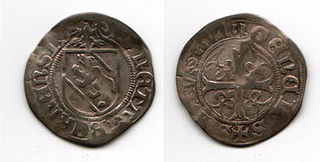
The batzen is an historical Swiss, south German and Austrian coin. It was first produced in Berne, Switzerland, from 1492 and continued in use there until the mid-19th century.

Groschen is the name for various coins, especially a silver coin used in parts of Europe such as France, some of the Italian states, England, various states of the Holy Roman Empire, among others. The word is borrowed from the late Latin description of a tornose, a grossus denarius Turnosus, in English the "thick denarius of Tours". Groschen was frequently abbreviated in old documents to gl, whereby the second letter was not an l, but an abbreviation symbol; later it was written as Gr or g.
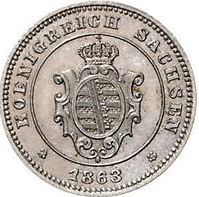
The Neugroschen was a Saxon Scheidemünze coin minted from 1841 to 1873 which had the inscription Neugroschen. This groschen, made of billon, was equivalent to the Prussian groschen but, unlike the latter, was divided not into 12, but into 10 pfennigs.
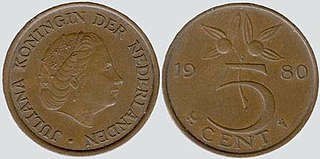
The stuiver was a coin used in the Netherlands, worth 1⁄20 Dutch Guilders. It was also minted on the Lower Rhine region and the Dutch colonies. The word can still refer to the 5 euro cent coin, which has almost exactly the same diameter and colour despite being over twice the value of the older coin.
The Weißpfennig was a form of silver groschen that was circulated in the Holy Roman Empire in the Late Middle Ages. It was also known as an albus or a Rhenish groschen. It was minted from the second half of the 14th century onwards in the Lower Rhine region by the four Rhenish electors of the Holy Roman Empire, who set up a joint mint in 1385–86. It was intended for everyday use, whilst the gold Rhenish gulden of the same era was intended as a trade coin. Those minted in Mainz were inscribed on one side 'Mainzer Rad' and were also known as Raderalbus.

The history of Saxon coinage or Meissen-Saxon coinage comprises three major periods: the high medieval regional pfennig period, the late medieval pfennig period and the thaler period, which ended with the introduction of the mark in 1871/72. Rich silver deposits, which were discovered near Freiberg after the middle of the 12th century, helped Saxony to a leading position in German coinage.
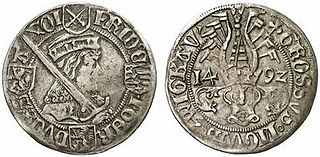
The Bartgroschen was a Saxon coin minted in 1492 and 1493 and embossed with an image of the bearded Duke Frederick III, the Wise (1486–1525). A total of 205,000 pieces were struck at the mints of Zwickau and Schneeberg. The groschen were the first Saxon coins with a portrait of the regent.

A Schüsselpfennig, also Gehulchter Pfennig is so called due to the stamping technique which results in a concave, one-sided type of Pfennig coin. It was probably first minted in 1374 in the Palatinate. Small Schüsselpfennigs that had entered the Electorate of Saxony were referred to there as Näpfchenheller.

The Meissen groschen or broad groschen was a Meissen-Saxon silver coin of the 14th and 15th centuries and the regional currency of the Margraviate of Meissen in the Late Middle Ages. It was introduced by Margrave Frederick II of Meissen in 1338/39 and modelled on the Prague groschen.
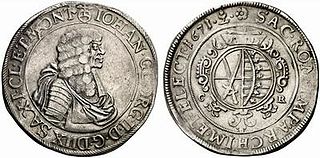
The Wechselthaler, also spelt Wechseltaler or Wechsel-Thaler, was minted in 1670 and 1671 in the Electorate of Saxony under Elector John George II (1656–1680) to the Wechselthaler or Burgundian thaler standard (861/1000 fineness). As the name suggests, the Wechselthaler and its subdivisions were intended as a currency to encourage Leipzig's trade with Hamburg and the Netherlands. The first coins from 1670 therefore bear the inscription WECHSELTHALER on the reverse. The Wechselthaler standard was only valid in Electoral Saxony in 1670 and 1671.

The Sachsenpfennig, sometimes called the Wendenpfennig or the Hochrandpfennig, was a well-known coin of the pfennig type minted in the eastern part of the Stem Duchy of Saxony during the 10th and 11th centuries. It had an upturned perimeter and, next to the Otto Adelheid Pfennig was the most common pfennig type of its time. Sachsenpfennigs are the oldest coins minted in Saxony. Its different names represent a lack of clarity within mediaeval numismatics about the coin.
The Meissen gulden, abbreviation Mfl., was a Rhenish Gold Gulden that was established in Saxony in 1490 at a value of 21 groschen and which, from 1542 to 1838 became a coin of account of the same value.

The Hessian Schildgroschen was a coin of the groschen type, based on the Meissen-Saxon Schildgroschen, one of the late medieval, Groschen period coins that was very similar to the Meissen Schildgroschen. It was also called the Kronichte Groschen and Zweischildgroschen.

The Roter Seufzer, also called the Seufzer and Leipziger Seufzer, was the popular name of the inferior six-pfennig coin minted in huge quantities in 1701 and 1702 by the Prince-Elector of Saxony and King of Poland, Augustus the Strong (1694–1733). The name of these coins was due to the loss that the population suffered as a result of the coins which had a high copper content.

The Guter Groschen, also Gutergroschen or Gutegroschen, abbreviation Ggr., is name of the groschen coin that was valued at 1⁄24 of a Reichsthaler from the end of the 16th century. It was called a "good groschen" to distinguish it from the lighter Mariengroschen, which was only valued at 1⁄36 Reichsthaler. The term Guter Groschen remained common until the middle of the 19th century.

The Bauerngroschen, also Burgroschen, was a groschen minted in the Free Imperial City of Goslar from 1477 until at least 1490 and continued to circulate until the 16th century. On the obverse it depicts a coat of arms with an imperial eagle beneath a helmet with a crown and on the reverse Saints, Simon and Jude. The two apostles were thought by the people to be farmers due to the poor quality stamping of the coins, hence the name, Bauerngroschen.

The schilling was the name of a coin in various historical European states and which gave its name to the English shilling. The schilling was a former currency in many of the German-speaking states of the Holy Roman Empire, including the Hanseatic city states of Hamburg and Lübeck, the March of Brandenburg, and the Duchies of Bavaria, Mecklenburg, and Württemberg. It was also used in Switzerland and in Austria, where silver schillings were introduced as recently as 1923.
The Andreas Hofer Kreuzer, also called the Hofer Kreuzer or Sandwirtszwanziger, was the name of the 20- and 1-kreuzer coins that were minted during the Tyrolean Rebellion in Hall in Tirol in 1809. The obverse depicts the Tyrolean Eagle and the inscription Gefürstete Grafschaft Tirol; the reverse shows the nominal value.

The Ewiger Pfennig or eternal penny was a coin of the regional pfennig period, which was minted until the late medieval groschen time. These coins are mostly of the Hohlpfennig or "hollow pfennig" type which, unlike bracteates, had to be exchanged regularly for a fee but were not subject to annual recall of coins in circulation, the Münzverruf.
















